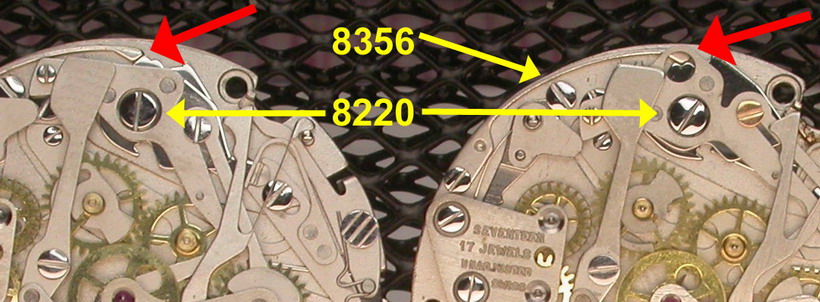| Informational Websites | ChronoMaddox -- the legacy of Chuck Maddox | OnTheDash -- vintage Heuer website | Zowie -- Omega information |
| Discussion Forums | ChronoMaddox Forum | Heuer Forum | Omega Forum |
| Counterfeit Watchers | ChronoTools Forum | ChronoTrader Forum |
|
|
The largest independent, non-commercial, consumer-oriented resource on the Internet for owners, collectors and enthusiasts of fine wristwatches. Online since 1998. | |||||||
|
||||||||
|
||||||||
 |
Vintage Heuer Discussion Forum
The place for discussing 1930-1985 Heuer wristwatches, chronographs and dash-mounted timepieces. Online since May 2003. | ||||||
| |||||||
| |||||||
Sometimes, it can be a curse beginning to ask these questions, as the answers are more complicated than we had imagined.
Jeff
+++++++++++++++++++++++++++++++++++++++
: 
: This 24229x Autavia (shown above) is an interesting one to study.
: Yes, it looks like a Caliber 12 movement, but you will notice
: that the big hammer at the top of the photo (8220) is the style
: of the Caliber 11 and Caliber 11-I, and not the style of a
: Caliber 12 hammer [see the photo below, where we compare the
: hammers]. Here is what we say about this hammer:
:
In the Caliber 11 and 11-I movements, the hammer cam jumper
: (8356) rested against the lower section of this hammer (8220),
: but there was nothing to prevent the hammer cam jumper (8356)
: from "jumping" out of position, coming to rest above
: the hammer (8220), which would result in the start / stop /
: reset being inoperable. In the Caliber 12 movement, the
: "head" of the hammer (8220) was made significantly
: larger, so that it "sandwiched" the hammer cam jumper
: (8356) in place and prevented it from jumping out of position. A
: large hole in the head of the hammer (8220) allows for oiling of
: the area of contact between the jumper and the hammer, and is an
: easy way to identify a Caibler 12 movement.
: So this movement, though it is marked Caliber 12 and has the
: gold-tone plates, may represent something of a transitional
: movement, between the Caliber 11-I and the Caliber 12. Perhaps
: most of the components are Caliber 12, but it still has this
: "leftover" hammer from Caliber 11-I. I have seen this
: exact same configuration before, in a 2409xx watch . . .
: movement was gold tone and marked Caliber 12, but it had the old
: style hammer (8220) . . . and, yes, it had the arrows on the
: case.
: Perhaps at this time (with the 240xxx to 242xxx serial numbers),
: Heuer was transitioning to the Caliber 12 movement, with the
: gold tone plates, and the Caliber 12 marked on the chronograph
: bridge (8500), but the improvements in the movement were not yet
: completed (so we see the old-style hammer).
: So I am still not convinced that we have seen a fully-developed,
: standard-issue Caliber 12 movement, in a case with the arrows on
: the lugs. I believe that these standard-issue production Caliber
: 12 movements would have a later serial number.
: Of course, there is another explanation: That Heuer had lots of
: these cases, with the arrows already marked, and they continued
: to use them up on their production watches, even after they had
: moved from Caliber 11-I to Caliber 12. This is a simple
: explanation, and we know that the simplest explanations are
: often best.
: Jeff
:
: 
: +++++++++++++++++++++++++++++++++++++
:
| Chronocentric and zOwie site design and contents (c) Copyright 1998-2005, Derek Ziglar; Copyright 2005-2008, Jeffrey M. Stein. All rights reserved. Use of this web site constitutes acceptance of the terms of use. | CONTACT | TERMS OF USE | TRANSLATE |